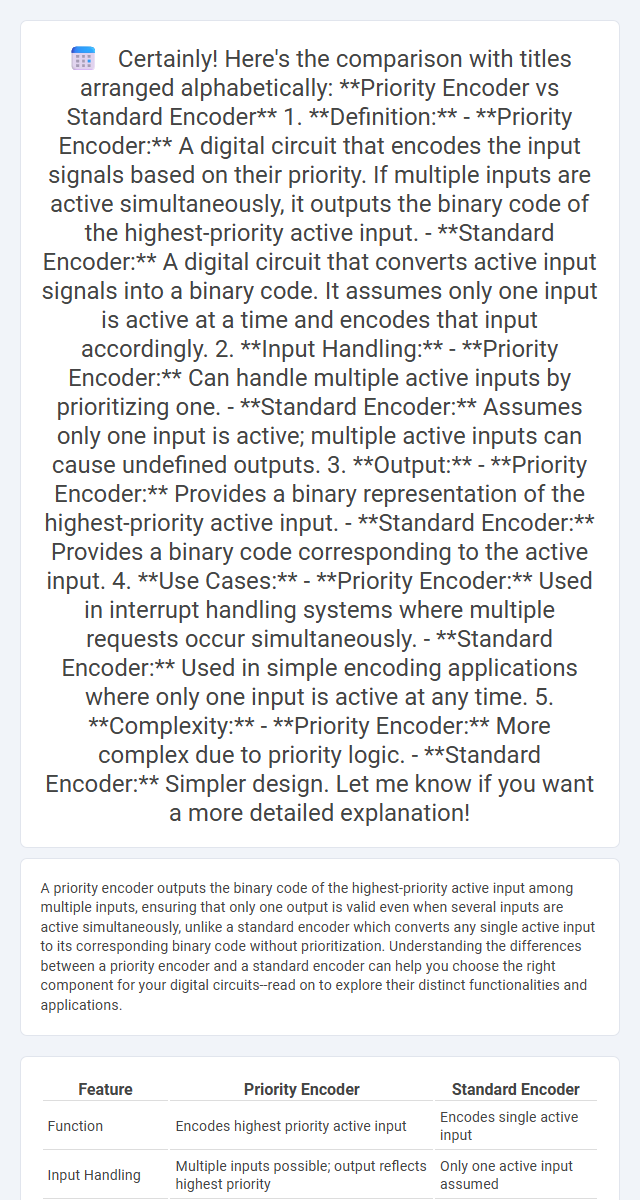A priority encoder outputs the binary code of the highest-priority active input among multiple inputs, ensuring that only one output is valid even when several inputs are active simultaneously, unlike a standard encoder which converts any single active input to its corresponding binary code without prioritization. Understanding the differences between a priority encoder and a standard encoder can help you choose the right component for your digital circuits--read on to explore their distinct functionalities and applications.
Table of Comparison
| Feature | Priority Encoder | Standard Encoder |
|---|---|---|
| Function | Encodes highest priority active input | Encodes single active input |
| Input Handling | Multiple inputs possible; output reflects highest priority | Only one active input assumed |
| Complexity | Higher, due to priority logic | Lower, simple encoding logic |
| Use Case | Interrupt handling, priority decision circuits | Basic signal encoding |
| Output | Binary code of highest priority input | Binary code of active input |
| Multiple Active Inputs | YES, resolves via priority | NO, invalid or undefined output |
Introduction to Encoders
Priority encoders and standard encoders both convert multiple input signals into a smaller, binary code output, but priority encoders assign significance to inputs, outputting the highest priority active input's code. Standard encoders generate output based solely on the active input without considering priority, making them less suitable for conflicting inputs. Priority encoders are commonly used in interrupt handling systems and multiplexers where input precedence is crucial for accurate processing.
What is a Standard Encoder?
A standard encoder is a digital circuit that converts multiple input signals into a binary code, representing the active input line without prioritization. Unlike a priority encoder, which assigns priority to inputs when multiple signals are active, a standard encoder assumes only one input is active at a time to generate the corresponding output. Understanding your application's requirement for conflict resolution helps determine if a standard encoder or a priority encoder is suitable.
What is a Priority Encoder?
A priority encoder is a digital circuit that encodes the highest-priority active input among multiple inputs into a binary code, ensuring that only the input with the highest priority is represented in the output. Unlike a standard encoder, which encodes any active input without prioritization, the priority encoder resolves conflicts when multiple inputs are active simultaneously by assigning precedence to inputs based on their priority levels. Priority encoders are essential in interrupt handling and resource arbitration in digital systems, where prioritizing signals is crucial for accurate and efficient processing.
Functionality Differences
A priority encoder outputs the binary code of the highest-priority active input among multiple inputs, ensuring that only the most important signal is encoded at a time. In contrast, a standard encoder encodes any active input without prioritization, often leading to ambiguous outputs if multiple inputs are active simultaneously. Understanding these functionality differences helps you select the right encoder type for applications requiring conflict resolution or simple input encoding.
Input and Output Configurations
Priority encoders differ from standard encoders in that their input configurations include multiple active inputs where the highest-priority input is encoded, while standard encoders require only one active input at a time. The output of a priority encoder represents the binary code of the highest-priority active input, whereas a standard encoder outputs the binary code corresponding to the single active input without priority consideration. Your choice between these encoders depends on whether handling simultaneous active inputs with priority is essential for your application.
Truth Table Comparison
A priority encoder outputs the binary code of the highest-priority active input, ensuring that when multiple inputs are active simultaneously, the input with the highest priority is encoded. The truth table of a standard encoder simply converts the active input line to its binary equivalent without considering priority, which can lead to ambiguous outputs if multiple inputs are active. Your system's performance depends on choosing the appropriate encoder type based on input priority requirements and how the truth table handles simultaneous active inputs.
Applications of Standard Encoders
Standard encoders are widely used in applications requiring the conversion of multiple input signals into a smaller number of outputs, such as digital data compression and keypad encoding. These encoders efficiently encode the active input line's binary equivalent, making them ideal for rotary or positional encoders and simple signal multiplexing. Your system benefits from standard encoders when straightforward priority handling is unnecessary, focusing instead on encoding the presence of single active inputs.
Applications of Priority Encoders
Priority encoders are widely used in interrupt controller circuits where multiple input signals need to be prioritized and processed based on urgency, ensuring critical signals gain immediate attention. They are also essential in digital systems for bus arbitration, allowing your device to select the highest priority request from multiple sources. Unlike standard encoders that simply encode multiple inputs into binary form, priority encoders enable efficient management of simultaneous inputs by assigning precedence to each signal.
Advantages and Limitations
Priority encoders provide the advantage of resolving conflicts by assigning priority levels, allowing Your digital system to identify the highest-priority input among multiple active signals, which standard encoders cannot do. Standard encoders, while simpler and faster for encoding unique inputs, lack the ability to handle simultaneous multiple inputs effectively, leading to ambiguous outputs. The limitation of priority encoders lies in their increased complexity and potential delay due to priority logic, contrasting with the straightforward design and quicker response time of standard encoders.
Summary: Choosing the Right Encoder
Priority encoders differ from standard encoders by assigning priority to inputs, ensuring the highest-priority active input is encoded, which is essential in applications requiring conflict resolution. Standard encoders simply convert active input lines to binary code without prioritization, suitable for straightforward encoding tasks with single active inputs. Selecting the right encoder depends on the complexity of input signals and the necessity for prioritization in digital systems design.
Priority encoder vs standard encoder Infographic

 electrown.com
electrown.com